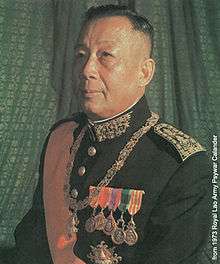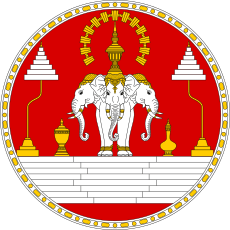Sisavang Vatthana
| Sisavang Vatthana | |
|---|---|
 | |
| King of Laos | |
| Reign | 29 October 1959 – 2 December 1975 |
| Predecessor | Sisavang Vong |
| Successor | Monarchy abolished; Prince Souphanouvong becomes President in 1975 |
| Born |
13 November 1907 Luang Phrabang, Laos |
| Died |
13 May?, 1978 or as late as 1984 Sam Neua, Laos |
| Spouse | Queen Khamphoui |
| Issue |
Crown Prince Vong Savang Princess Savivanh Savang Princess Thala Savang Prince Sisavang Savang Prince Sauryavong Savang |
| House | Khun Lo Dynasty |
| Father | Sisavang Vong |
| Mother | Kham-Oun I |
Sisavang Vatthana (Lao: ເຈົ້າສີສະຫວ່າງວັດທະນາ) or sometimes Savang Vatthana (full title: Samdach Brhat Chao Mavattaha Sri Vitha Lan Xang Hom Khao Phra Rajanachakra Lao Parama Sidha Khattiya Suriya Varman Brhat Maha Sri Savangsa Vadhana; 13 November 1907 – 13 May 1978 ~ 1984) was the last king of the Kingdom of Laos. He ruled from 1959 after his father's death until his forced abdication in 1975. Savang Vatthana proved unable to manage a country in political turmoil. His rule ended with the takeover by the Pathet Lao in 1975, after which he and his family were sent to a re-education camp by the new government.[1]
Early life
Prince Savang Vatthana was born on 13 November 1907 at the Royal Palace of Luang Prabang, the son of King Sisavang Vong and Queen Kham-Oun I. He was the second of five children along with Princess Khampheng, Princess Sammathi, Prince Sayasack, and Prince Souphantharangsri. He was also a distant cousin of Prince Souvanna Phouma and Prince Souphanouvong. At the age of 10, Prince Savang was sent to study in France. He attended a lycée in Montpellier and obtained a degree from École Libre des Sciences Politiques (now called Sciences Po) in Paris, where French diplomats were trained. The young heir continued his studies in France, and after a decade overseas, he could no longer speak Lao. Upon his return, he had to be instructed by a palace functionary for years.
On 7 August 1930, he married Queen Khamphoui and they had five children, Crown Prince Vong Savang, Prince Sisavang Savang, Prince Sauryavong Savang, Princess Savivanh Savang, and Princess Thala Savang. The family played tennis together, and liked to attend major tournaments on their travels abroad. The prince was also a devout Buddhist and became an authority on the sangkha, and would later took his role as protector of the state religion seriously.

During World War II, he represented his father with the Japanese forces. His father sent him to the Japanese headquarters in Saigon, where he vigorously protested about the Japanese actions, when they invaded Laos and forced them to declare independence from France.
King of Laos

In 1951, he served as Prime Minister, and when his father became ill on 20 August 1959, he was named Regent. On 29 October 1959, he informally acceded upon the death of his father. He was, however, never officially crowned and anointed king, deferring his coronation until the cessation of civil war. During his reign, Savang Vatthana visited many countries on diplomatic missions. In March 1963, he toured 13 countries, including the United States, where he stopped at Washington, D.C. to meet with President Kennedy. It was the second stop on a tour of 13 of the nations signatory to the Geneva Pact that guaranteed the "neutrality" of the Kingdom of Laos. The first stop had been Moscow, and the Russians showered gifts, including Chaika limousines. He was also accompanied by his Prime Minister, Souvanna Phouma.
| Styles of King of Laos | |
|---|---|
| Reference style | His Majesty |
| Spoken style | His Majesty |
| Alternative style | Sir |
He was active in Lao politics, trying to stabilise his country after the political turmoil started with the Geneva Conference of July 1954, which granted full independence to Laos but did not settle the issue of who would rule. Prince Souvanna Phouma, a neutralist, operated from Vientiane, claiming to be Prime Minister and being recognized by the USSR; Prince Boun Oum of Champassak in the south, right-wing, pro-US, dominated the Pakse area, recognized as Prime Minister by the US; and in the far north, Prince Souphanouvong led the leftist resistance movement, the Pathet Lao, drawing support from North Vietnam, also claiming to be Prime Minister with the backing of the communists. To avoid argument over whether Souvanna or Boun Oum was the "legitimate" Prime Minister, both sides would deal through the pro-western King Savang Vatthana.
In 1961, a majority of the National Assembly had already voted Boun Oum into power and King Savang Vatthana left Luang Prabang, visiting the capital to give the new government his blessing. But he wanted the Three Princes to form a coalition government, which happened in 1962 but then the coalition government collapsed.
In 1964 series of coups and counter coups resulted in the final alignment of the Pathet Lao on one side with the neutralist and right wing factions on the other. From this point the Pathet Lao refused to join any offers of coalition or national elections and Laotian Civil War began.
Abdication and death
On 23 August 1975, Pathet Lao forces entered Vientiane, the last city to be captured. The Phouma Government became effectively powerless for the next few months. On 2 December, Vatthana was forced to abdicate the throne by the Pathet Lao, abolishing the 600-year-old monarchy, and was appointed to the meaningless position of "Supreme Advisor to the President".[2] He refused to leave the country and in 1976 he surrendered the royal palace to the Lao Government, which turned it into a museum, and moved to a nearby private residence where he was later placed under house arrest. In March 1977, fearing Vatthana might escape to lead a resistance, the Communist authorities arrested him along with the Queen, Crown Prince Vong Savang, Prince Sisavang, and his brothers Princes Souphantharangsri and Thongsouk and sent them to the northern province of Viengxai.[3] He was transported to Sam Neua and imprisoned in "Camp Number One," which held high-ranking officials from the former government.[4] During his time in the camp, the royal family was allowed to move freely around in their compounds during the day and were often visited by members of the politburo and Sopuhanouvong himself. He was the oldest prisoner in the camp and turned 70 during the earlier months of imprisonment, whereas the average age of prisoners was around 55.[5]
In 1978, the government reported that Vatthana, Queen Khamphoui, and Crown Prince Vong Savang had died from malaria.[6] More recent accounts suggest that the King died in mid-March 1980. However, according to Kaysone Phomvihane, Vatthana died in 1984, at the age of 77.[7] With Vatthana and the Crown Prince's deaths, the King's youngest son Sauryavong Savang became the head of the Laotian royal family, acting as regent to his nephew Crown Prince Soulivong Savang. Other accounts claim the royal family were forced to do hard labor and given little food in the camp, contributing to their health deteriorating.[8]
Issue
The children of Savang Vatthana and Khumphoui as follows:
| Name | Birth | Death | Notes |
|---|---|---|---|
| Crown Prince Vong Savang | 27 September 1931 | 2 May 1978 (?) | married Mahneelai |
| Princess Savivanh Savang | 1933 | 4 January 2007 | married Mangkhala Manivong |
| Princess Thala Savang | 10 January 1935 | 14 April 2006 | married Sisouphanouvong Sisaleumsak |
| Prince Sisavang Savang | December 1935 | 1978 | |
| Prince Sauryavong Savang | 22 January 1937 | ||
See also
References
- ↑ Royal Ark
- ↑ https://news.google.com/newspapers?nid=1300&dat=19751204&id=a8dYAAAAIBAJ&sjid=QJIDAAAAIBAJ&pg=7119,940024
- ↑ http://www.lonelyplanet.com/laos/history#ixzz1vbXPh1dn
- ↑ https://books.google.com.au/books?id=dWIj5Q8l08wC&pg=PA398&lpg=PA398&dq=camp+number+one+savang&source=bl&ots=OHtMVH93kC&sig=2JnJ7k2AIWV4ULp4WBetRD42wRM&hl=en&sa=X&ved=0CBsQ6AEwADgKahUKEwiI7Mql0tPIAhWDKpQKHcqLBAY#v=onepage&q=camp%20number%20one%20savang&f=false
- ↑ Bamboo Palace, Kremmer . 2003, p. 1989. accessed on May 10, 2008.
- ↑ http://www.nytimes.com/1990/02/08/opinion/l-laotian-royal-family-died-in-prison-camp-282890.html
- ↑ Laos " Le roi est mort ", Le Monde. 16 December 1989, p. 7. accessed on October 8, 2006.
- ↑ http://factsanddetails.com/southeast-asia/Laos/sub5_3a/entry-2943.html
External links
| Wikimedia Commons has media related to Savang Vatthana. |
- Laos - "Seminar Camps" And The Death Of King Savang Vatthana
- Photographs of Royal Family of Laos
- Biography of King Sauryavong Savang (French)
- Death of King Savang Vatthana reported
| Sisavang Vatthana Cadet branch of the 1984? Born: 13 November 1907 Died: March 1978?/13 May | ||
| Regnal titles | ||
|---|---|---|
| Preceded by Sisavang Vong |
King of Laos 29 October 1959 – 2 December 1975 |
Monarchy abolished |
| Political offices | ||
| Preceded by Sisavang Vong as King of Laos |
Head of State of Laos as King of Laos 29 October 1959 – 2 December 1975 |
Succeeded by Prince Souphanouvong as President of Laos |
| Preceded by Phoui Sananikone |
Prime Minister of Laos 15 October 1951 – 21 November 1951 |
Succeeded by Prince Souvanna Phouma |
| Titles in pretence | ||
| New title | — TITULAR — King of Laos 2 December 1975 – March 1978?/13 May 1984? |
Succeeded by Vong Savang |
